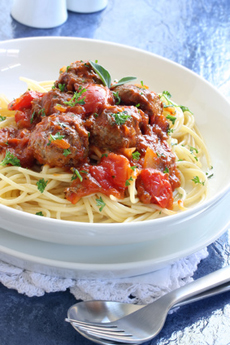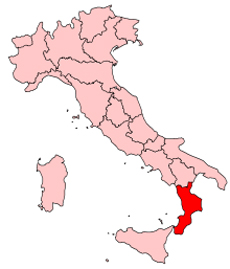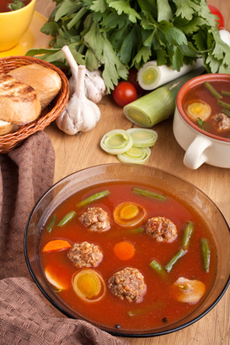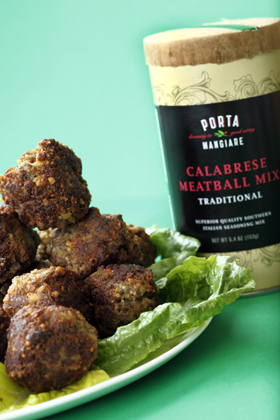
 Beefy, cheesy meatballs add pizzazz to everyday spaghetti. Photo by Robyn Mac | Fotolia. Beefy, cheesy meatballs add pizzazz to everyday spaghetti. Photo by Robyn Mac | Fotolia.
|
CHRISTINA GONZÁLEZ is an editorial intern at THE NIBBLE.
|
|
August 2010
|
 |
Porta Mangiare Meatball Mixes
Authentic Italian Meatball Recipes
CAPSULE REPORT: Want foolproof, tasty meatballs? Porta Mangiare gives you all the seasonings; you just add beef or turkey plus grated cheese and an egg. The handsomely boxed mixes make welcome gifts and stocking stuffers.
Porta Mangiare Meatball Mix Overview
Porta Mangiare meatball mixes are intended to recapture the flavors of Calabrian cooking as it was a century ago.
The cuisine of Calabria is simple and hearty: olive oil, vegetables, soups, spaghetti or penne topped with tomato sauces plus combinations of tomatoes, eggplant and bell peppers. The meat is most often pork: spicy dried salame, sopressata or PDO-protected smoked capocollo di Calabria, a type of capicola made from pork shoulder. Meatballs are a treat rather than everyday fare.
The directions that accompany Porta Mangiare meatball mix call for baking, but you can also pan-fry the meatballs, which is how we prepared them. The mixes are made with breadcrumbs and a custom spice blend, to which you add 2 eggs, six ounces of cheese, a pound of ground meat (turkey, beef or a beef-pork mix) and water or milk.
Six ounces of grated cheese may seem like a lot, but each box makes five servings (of three meatballs each) per package.
CHEESE NOTE: Buy a wedge of cheese and grate it yourself: It’s cheaper and much better than pre-grated cheese in a plastic container or (gasp!) what passes for pre-grated cheese in a cardboard tube. If you don’t own a box grater, microplane or other grating device, consider a Zyliss rotary grater. Be sure to purchase the model that has both fine and coarse grating drums because you’ll use both in different circumstances.
|
|

Calabria is the front portion of the “boot” of Italy. Map courtesy Wikimedia. |
Now for the meatballs:
The results were crisp, light and moist. We’re not certain if the Pecorino Romano cheese we used made them taste a bit salty. Next time we’ll try Parmesan, Asiago or Grana Padano, which are less saltier grating cheeses. (See the differences between Italian grating cheeses.) You can use them in:
- Pasta dishes
- Grain dishes (try turkey meatballs with vegetable couscous as a main course)
- Meatball hero sandwiches
- Vegetable soup or consommé
- Hors d’oeuvres, with a dipping sauce (make them smaller)
Meatball Mix Varieties
There are currently four varieties of meatball mix. We tried the Traditional Calabrese and Spicy Calabrese varieties.
- Spicy Calabrese Meatball Mix, the Traditional amped up a bit with red pepper and paprika, for those who enjoy a bit of a kick.
- Traditional Calabrese Meatball Mix, moist and cheesy.
- Turkey Calabrese Meatball Mix, a different formulation to accommodate the learner turkey meat.
- Gluten-Free Traditional Calabrese Meatball Mix, made with potato flakes instead of bread crumbs.
The taste and texture of the Traditional meatballs reminded us a bit of arancini (fried risotto balls made with Parmesan cheese and mozzarella). In fact, the cheese is arguably the star in these meatballs.
|
|

Enjoy meatballs in homemade vegetable soup. Photo © Olga Nayashkova | Fotolia. |
For those who prefer their meatballs very heavy and meaty, these mixes might not be right. They don’t create the oversized meaty hunks you’ll find most often in Italian-American cooking. But for those who like a lighter texture, with a very nice union of beef and Parmesan flavor, they make for a tasty lunch or dinner. And the recipe in the package gives you the option to make the meatballs meatier by adding an extra half-pound of meat.
A historic note: Originally, in Italy, meatballs were made with bread, rice or other fillers because meat was expensive and a little had to be stretched a long way. Jumbo all-beef meatballs are an Italian-American invention: Meat in the U.S. was affordable even for immigrants starting out. Porta Mangiare meatball mix takes us back to the meatball’s origin.
Try a box or two—and order extras for gifts and stocking stuffers. No one will mind having to BYO meat.
PORTA MANGIARE
Meatball Mixes In Gluten-Free Traditional Calabrese, Spicy Calabrese, Traditional Calabrese & Turkey
- Meatball Mix
5.4 Ounces (Makes About 15 Medium Meatballs)
$5.99
- Gluten-Free Meatball Mix
3 Ounces (Makes About 15 Medium Meatballs)
$6.99
Purchase online* at PortaMangiare.com
Go To The Article Index Above |
|

Photo by Katharine Pollak | THE NIBBLE.
|
*Prices and product availability are verified at publication but are subject to change. Shipping is additional. These items are offered by a third party and THE NIBBLE has no relationship with them. Purchase information is provided as a reader convenience.
Lifestyle Direct, Inc. All rights reserved. Images are the copyright of their individual owners.

|




 Beefy, cheesy meatballs add pizzazz to everyday spaghetti. Photo by Robyn Mac | Fotolia.
Beefy, cheesy meatballs add pizzazz to everyday spaghetti. Photo by Robyn Mac | Fotolia. 

